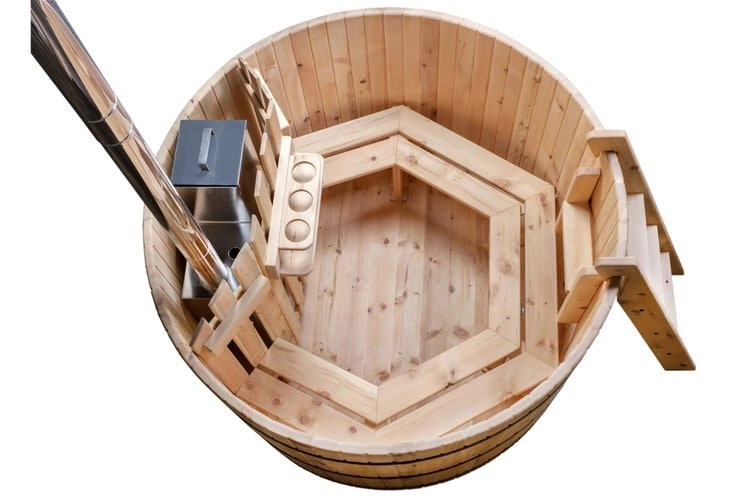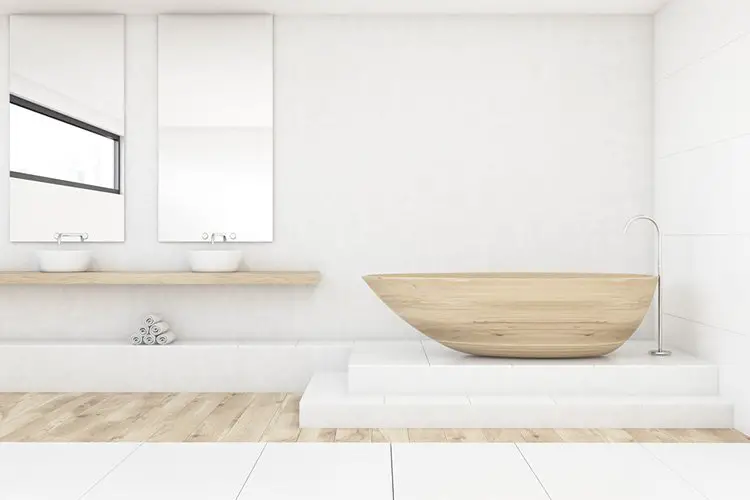Your bathroom tub should be your haven. Somewhere you go to relax and unwind at the end of a hectic day. A luxury bathroom is usually high on every homeowner’s wish list, and revamping your bathroom allows you to create a serene environment that meets your needs.
If you’re in the market for a new unique soaking tub, something that’s not only functional but is also a centerpiece for your bathroom, you should look no further than Japanese soaking tubs. While they can be made from a variety of materials, these soaking tubs give an urban and sleek aesthetic for your modern home.
What Is a Japanese Soaking Tub?
A Japanese soaking tub is a small, deep bathtub. The soaking tub is designed to place as much of the body as possible immersed into the water. Many are designed with an in-built bench to facilitate sitting upright instead of lying down—providing you with ultimate bathing comfort by supporting the body and allowing you to lean back and let go.
These unique bathtubs are great for small bathrooms since they provide a comfortable, deep soak while taking up so little bathroom space. The Japanese soaking tub is becoming popular in modern bathrooms because of its small footprint, distinct style, and therapeutic abilities.
The history of Japanese Soaking Tubs

In Japanese, Ofuro, which means ‘bath,’ has always had significant importance in the community’s culture to cleanse the body and soul. The ofuro is meant to relax and warm the body and is not meant for the purpose of washing.
The history of Japanese bathing started with hot springs. Japan is both cursed and blessed with volcanic activity on its mountains. Studies show that Japan ranks third in the world for the country with the most volcanos, with about 270 volcanos. Although every once in a few hundred or thousand years, these volcanos would cause havoc in nearby neighborhoods, this thermal activity would also give the entire country many natural hot springs where the communities would soak.
Although soaking in an open-air natural spring was something that the Japanese liked to do, sometimes these springs were too far from where they lived. Warlords and investors had also bought many natural hot springs to build inns or keep the springs private, shutting the communities out. To make bathing more accessible to the average person, the communities built local bathhouses during the Edo Era (1603-1868). The hot spring water was piped in, and wells were drilled to bring the hot water to the surface. During this era, the ‘Sue Furo,’ a private type of bath emerged in homes that were heated and allowed people to submerge their bodies up to their shoulders.
In 1964, the unit bath, commonly referred to as the Japanese soaking tub, was introduced to Japan in preparation for the Tokyo Olympics. The soaking tubs revolutionized the housing market and were installed in many apartments. They could be easily installed, were easy to clean, and had everything a person needed in one small unit.
Traditional vs. Modern Japanese Soaking Tubs

Traditional Japanese soaking tubs were built using fragrant cypress wood, referred to as ‘Hinkoki’—the same wood used to build temples. There was a bench or in-built seat inside the tub where one would sit on as they soaked. As the popularity of these tubs increased, so did the materials used to build them. Cedar, copper, steel, stone, and acrylics were also used to make Japanese soaking tubs.
The Japanese never washed in the soaking tubs. The tubs were entirely dedicated to relaxation. They cleaned themselves before getting into the tubs. They mainly used the tubs to soak themselves, which allowed them to rejuvenate themselves and relax.
Modern Japanese soaking tubs are tall and incorporate a seat. They can be made from various materials, including acrylics, stainless steel, marble, composite, and copper. They provide about 27 inches of water depth to ensure that the standard adult is immersed to their shoulders when inside the tub.
The modern Japanese soaking tub comes in different shapes, styles, and sizes—from single-person baths to large sizes that accommodate many people. They can also be custom-made to fit your preferences. Modern soaking bathtubs can also withstand high temperatures compared to traditional ones.
View this post on Instagram
Advantages of a Japanese Soaking Tub
- They bring the aspect of comfort to bathing
- They save on space
- They have a unique look
- They use less water than the conventional bath of the same dimension
- They provide different mounting options
- They are easier to enter or exit since they are sunken or have a removable or fixed step. Therefore, these tubs are safer than the standard bathtub since at no point does the bather have to balance.
- Faucets or taps can be mounted in any location where space allows.
Health Benefits of Using Japanese Soaking Tubs
Researchers have studied the benefits of bathing in hot water extensively. The health benefits of soaking in Japanese soaking tubs include:
- Improves heart health: Taking a warm bath makes your heart beat faster and gives it a healthy workout.
- Helps cure chronic joint and back pain: Hot showers enhance blood flow and help soothe sore and tight muscles. Warm baths have also been proven to help reduce pain and inflammation in the joints.
- Helps lower blood pressure: Taking a regular warm bath can help reduce blood pressure. As a result, reduced blood pressure can help prevent more severe heart conditions like stroke or heart attack.
- Helps heal cold and flu: Breathing in the steam from a hot tub has long been used as a natural remedy to cure cold and flu symptoms.
- Improves breathing: The temperature of the water and the pressure it places on your chest and lungs influence your lung capacity and oxygen intake, improving your breathing.
- Helps burn calories: Sweat induced by a hot bath can burn as many calories as a walk.
- Improves the body’s immunity: Improves the body’s immunity
- Helps to treat headaches: Most headaches are caused by narrowing blood vessels in the head. A hot bath will help dilate these blood vessels and cure your headache.
- Increases the process of healing: Increased blood flow helps to kill bacteria and improve immunity.
Japanese soaking tubs are not only beautiful to look at, they provide a meditative space to relax at the end of the day. A healthy and calming ritual and contributing factor to the health and longevity found in Japanese culture.

